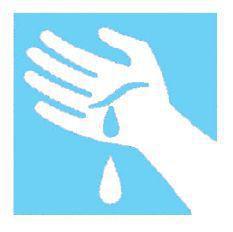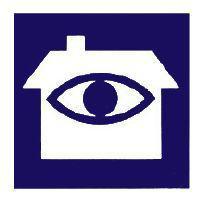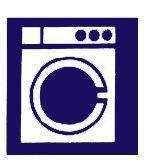SAS Urban Survival Handbook (20 page)
Read SAS Urban Survival Handbook Online
Authors: John Wiseman
Tags: #Health & Fitness, #Reference, #Survival, #Fiction, #Safety, #Self-Help, #Personal & Practical Guides, #General, #Survival Skills

GLASS
 Ordinary window glass shatters easily, breaking into sharp-edged, often dagger-like pieces. Areas which are more vulnerable to impact should be fitted with safety glass instead. There are two main kinds.
Ordinary window glass shatters easily, breaking into sharp-edged, often dagger-like pieces. Areas which are more vulnerable to impact should be fitted with safety glass instead. There are two main kinds.
Toughened glass
is processed to be five times stronger than ordinary glass, withstanding both rapid temperature change and impact. Instead of breaking into large pieces, it shatters into small granules. It must be ordered to size.
Laminated glass
consists of layers of glass bonded together with a strong clear plastic film between them. It absorbs some of the energy of impact, and reduces the danger of flying fragments of glass. However, this sort of glass should never be used in the home for a window which might need to be used as an escape route—in a fire, for example. It can be
VERY
difficult to break through.
Ordinary glass can be made safer by applying a special adhesive film to the surface. This stays clear once fixed and holds the glass together if it is broken.
Many accidents involve people walking into doors or even windows which they have not seen. Glass partitions, including windows onto patios and balconies, should have barriers which prevent people walking right up to them or decoration on the panel which will draw attention to its surface. Glass doors should always carry some form of decoration. Though the glass may not shatter, the impact can do considerable injury.

EMERGENCY!
BLEEDING
Small cuts may be cleaned and dressed. If bleeding does not stop, cover with a dressing and apply pressure to control it.
LARGE WOUNDS/SERIOUS BLEEDING
Call for an ambulance. Cover with a dressing and apply pressure, elevating the bleeding limb. If necessary, hold the wound closed. If there is a foreign body in the wound, do not attempt to remove it—it may stem some of the bleeding.
ROOM CHECK
 Make a close inspection of your home and consider the risks which each room presents to you and your family. Do not forget the hazards posed for the very young and the elderly. Even though they may not be part of your live-in family, your home should also be safe for visitors.
Make a close inspection of your home and consider the risks which each room presents to you and your family. Do not forget the hazards posed for the very young and the elderly. Even though they may not be part of your live-in family, your home should also be safe for visitors.
KITCHEN
 A safe kitchen is a kitchen planned for efficiency. Work surface, cooker, sink, cupboards and equipment should be arranged to minimize movement between them. You will find, in most kitchens, that you usually move in a triangle when preparing food. The points of the triangle are usually fridge/sink/cooker. Avoid any triangular arrangement which crosses another access route.
A safe kitchen is a kitchen planned for efficiency. Work surface, cooker, sink, cupboards and equipment should be arranged to minimize movement between them. You will find, in most kitchens, that you usually move in a triangle when preparing food. The points of the triangle are usually fridge/sink/cooker. Avoid any triangular arrangement which crosses another access route.
Watchpoints
COOKERS
Avoid placing the cooker under a window or next to a door. It would be easy to burn yourself reaching across to open the window. Pots could be knocked when coming through the door. In both positions draughts could blow out low flames on a gas cooker. With built-in ovens check the position of air-vents which may blow hot air out at you. Beware of external cooker surfaces, they can get hot enough to give you a bad burn. Don’t stand over the oven door when opening it—the blast of hot air and steam could be nasty.
Have heat-resistant working surfaces next to the hob and oven to take hot pans and dishes. Have the sink within easy reach for draining/straining and for transferring heavy pans for washing. Clean the cooker regularly—the build-up of grease and dirt around an oven can become a fire hazard. Cookers on wheels (with a flexible attachment to the mains in the case of gas supplies) enable a thorough cleaning job to be done behind as well as all over the oven itself.
STORAGE
Store all food and equipment close to the place where it will be used: for instance, place vegetable storage near the sink. Avoid placing cupboards or shelving over the hob, or hanging anything there. Reaching over it could easily set clothes alight. Do not warm or store dishes above the hob for the same reason. If you have to use high cupboards, do not keep frequently-used objects in them. Get a set of kitchen steps rather than standing on chairs or stools.
DANGER
Do not have plugs for kettles or appliances near the hob—flex trailing across the burners or hotplates could easily be charred or burned. Do not have television or mains radios near the sink or where leads have to pass near the cooker. Keep electric flexes well away from water and places where they could constitute an ELECTROCUTION hazard.
FLOORS
Keep floors clean and mop up spillages immediately—spills can make them dangerously slippery—but avoid unnecessary polishing. Carpets are not usually practicable in a kitchen—though types are now available which are easily cleaned—NEVER use loose rugs in a kitchen.
PLUS
Many people feed pets in the kitchen but cats or dogs under the feet, especially if pestering for food, can be a hazard. Do not allow cats on work surfaces. Can you find a more appropriate pets’ corner? Keep the kitchen well-ventilated. Cooking produces a lot of steam and a washing machine in the kitchen will add to that. Condensation not only steams up windows but can make floors slippery too.
CHILDPROOFING
- ■
If you need to have small children in the kitchen, keep them out of harm’s way by constructing a partition so that they are out of the work area. - ■
Fit child-resistant catches on low-level cupboards—especially if you keep bleaches and cleaners underneath the sink. Ideally, store potential poisons out of a child’s reach. - ■
Keep knives and other dangerous equipment out of sight of children. - ■
Fit a guard round the hob so that pans cannot be pulled down from it. If possible, cook on back rings, where handles are out of reach. - ■
Split-level, high-set ovens will keep one danger area out of reach of very small children. - ■
Avoid flexes hanging from kettles, irons or other electrical equipment, which children could pull. Coiled flexes are safer than trailing ones. Keep kettles at the back of work surfaces—out of reach and sight of toddlers. - ■
Do not use long tablecloths which children could tug, pulling hot food and sharp utensils down on top of them. - ■
Teach children that cookers—not just hobs but oven doors and sides—are hot and can burn. - ■
Children use drawer units as stepladders. Fit latches to lock drawers. - ■
Don’t store children’s drinks where you keep alcohol.
Electric cookers
Some small cookers, including microwaves, are below 3000 W rating, and can be connected to a 30-amp ring main circuit. Most ordinary electric cookers are over 3000 W and require a separate circuit, run directly from the consumer unit, via a cooker control unit which must be within 2 m (6 ft 6 in) of the cooker. This unit has an isolating switch, but is sometimes combined with a socket for use with an electric kettle or other appliances.
The gauge of cable used and the fuses required will depend upon the power consumption of the cooker, which should be indicated on the appliance (see
Electricity
).
Some ovens use a cleaning system in which the surfaces are specially coated and the oven is run at a high temperature to burn dirt off. Follow the instructions carefully. In all other cases ensure that the oven and/or rings are switched off before starting to clean.
Microwave ovens
Microwave ovens cook food through the action of high-frequency radio waves which quickly penetrate the food, vibrating the water molecules within it to produce heat and rapid cooking. Leakage of microwaves can have harmful effects, but ovens have to meet official safety requirements. If the door or seals of an oven appear damaged, or its performance changes, get it checked—do NOT take risks.
DON’T allow grease or dust to accumulate around the seal or door frame. The door must close properly. DON’T peer closely through the door at regular intervals. Leakages are more dangerous inches from the oven.

WARNING
Microwave radiation is very dangerous. In perfect condition, ovens are designed so that the radiation is entirely contained and is switched off when the door is opened. Nevertheless any tampering with the system or inefficient cleaning could result in radiation being released. NEVER allow an unqualified person to attempt to repair a microwave. If you suspect any malfunction take it to the suppliers or their service centre.
Ovens MUST cut out when the door is opened and some are now equipped with cut-out mechanisms if they become overheated—but there is a considerable risk of fire if food is allowed to cook for too long or instructions are not followed.
NEVER put oven foil, metal dishes or dishes decorated with metal in a microwave. Since many ceramic colour glazes and paints contain metallic elements, it is safest to use only dishes which are designed for microwave ovens.
